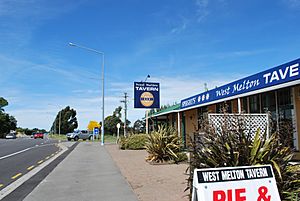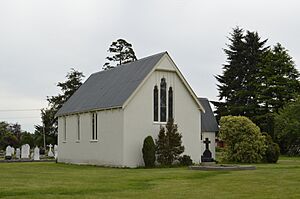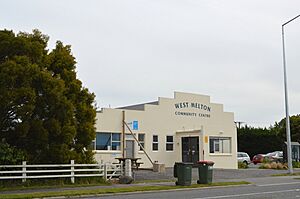West Melton, New Zealand facts for kids
Quick facts for kids
West Melton
|
|
|---|---|
|
Minor urban area
|
|

West Melton Tavern, 2011
|
|
| Country | New Zealand |
| Ward | Malvern |
| Community | Malvern |
| Electorates |
|
| Area | |
| • Total | 2.99 km2 (1.15 sq mi) |
| Elevation | 88 m (289 ft) |
| Population
(June 2023)
|
|
| • Total | 2,450 |
| • Density | 819.4/km2 (2,122/sq mi) |
| Time zone | UTC+12 (New Zealand Standard Time) |
| • Summer (DST) | UTC+13 (New Zealand Daylight Time) |
| Local iwi | Ngāi Tahu |
West Melton is a cool town in the Selwyn District of New Zealand. It's located in the Canterbury region, which is on the South Island! It's about 24 kilometers (15 miles) west of Christchurch and is part of the bigger Christchurch area. Around 2,450 people live here (as of June 2023). That makes it the 123rd biggest town in New Zealand, and the fifth largest in the Selwyn District.
Contents
A Look at West Melton's History
West Melton was first settled in the 1870s. For a long time, it was known for horse racing (especially trotting), growing crops, and raising sheep. More recently, people have started growing grapes for wine and farming deer. In 1881, a person named Alfred Saunders bought a farm here. He called it a "bleak and wild looking property."
On October 26, 2014, the people of West Melton celebrated a big birthday for their town. It was 150 years old!
How West Melton Grew
In 2007, West Melton started to grow a lot. New housing areas, called subdivisions, began to be built. Gainsborough and Halkett Grove were the first ones. Then came Preston Downs, and Wilfield was built to the south.
More new housing areas are planned for the future. One new subdivision will be built east of Gainsborough. Also, a special village for older people is planned west of Preston Downs. This growth shows how popular West Melton is becoming!
Sometimes, this growth can cause disagreements. When new houses are built on land that used to be for farming, it can create tension. Farmers and new residents sometimes have different ideas about how the land should be used.
People of West Melton
West Melton is considered a small urban area by Statistics New Zealand. It covers about 2.99 square kilometers (1.15 square miles). As of June 2023, it has an estimated population of 2,450 people. This means there are about 819 people living in each square kilometer.
| Historical population | ||
|---|---|---|
| Year | Pop. | ±% p.a. |
| 2006 | 327 | — |
| 2013 | 780 | +13.22% |
| 2018 | 2,085 | +21.73% |
| 2023 | 2,450 | +3.28% |
In 2018, West Melton had 2,085 people living there. This was a big jump from 2013, when there were only 780 people. The town is growing quickly!
Most people in West Melton are of European descent (94.0%). There are also people who identify as Māori (5.9%), Asian (5.2%), and other backgrounds. About 19% of the people living here were born outside of New Zealand.
When it comes to religion, many people (51.9%) say they don't have a religion. About 40.1% are Christian. A small number of people follow other religions like Hinduism, Islam, or Buddhism.
Many adults in West Melton have a university degree (28.9%). The average income here is higher than the national average. This means many people have good jobs. Most adults (59.8%) work full-time.
Services and Fun in West Melton
West Melton has a handy shopping area. You can find a Four Square supermarket for groceries. There's also a community centre where people can gather. The town has its own primary school for younger students.
If you love planes, the West Melton Aerodrome is nearby. And if you're interested in stars and planets, the Canterbury Astronomical Society is also in the area.
For outdoor fun, there's a cool skate park and a playground next to the community centre. The skate park was finished in 2022, and the playground was ready in 2023.
Education in West Melton
West Melton School is a school for students from Year 1 to Year 8 (ages 5-13). It's a full primary school, meaning it covers all those years. As of February 2024. , it has a roll of 436 students. The school first opened its doors way back in 1871!
Getting Around West Melton
Bus Travel
West Melton has a bus service called the 86 bus route. This bus runs on weekdays in the morning and evening. It connects Darfield to the center of Christchurch.
Roads and Driving
The main road through West Melton is State Highway 73. This highway goes right through the middle of town. West Melton is also close to the new part of the Christchurch Southern Motorway. You can get to it easily using the Weedons Ross Road Interchange.
In a big change for the town, West Melton got its first set of traffic lights on March 20, 2023. They were turned on at the intersection of State Highway 73 and Weedons Ross Road.
Sports in West Melton
Moore Park Speedway is a cool place for motorcycle speedway racing. It's about 5 kilometers (3 miles) north of West Melton, on Weedons Ross Road. It's right next to the West Melton airfield. This track is a really important place for big motorcycle speedway events. It has hosted the final race for the New Zealand Solo Championship several times, including in 2012, 2015, 2018, and 2021.
Images for kids




